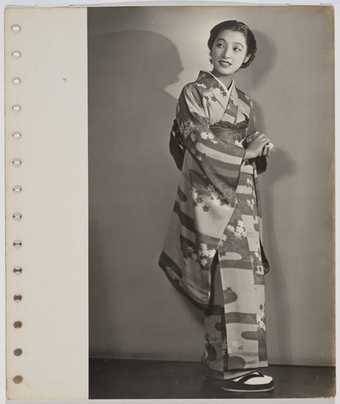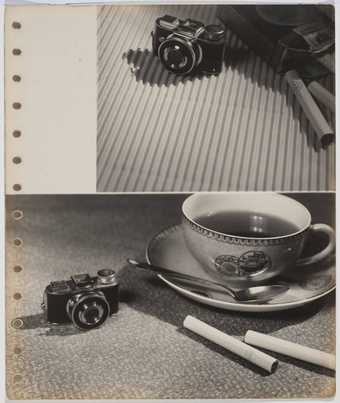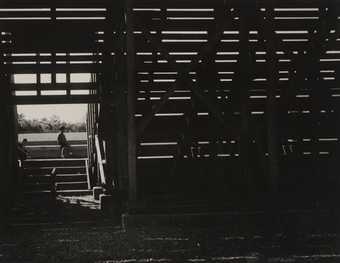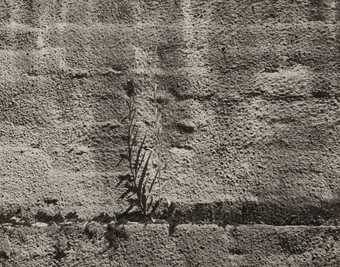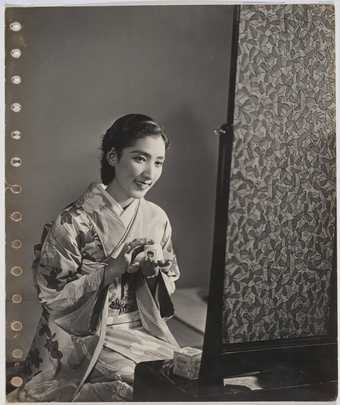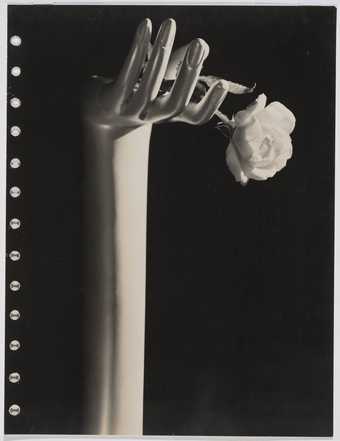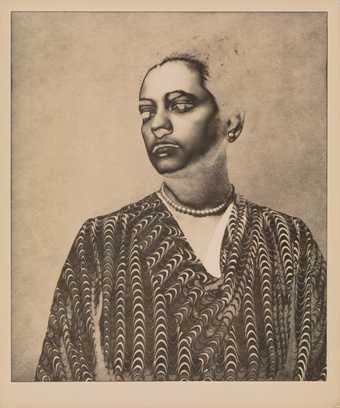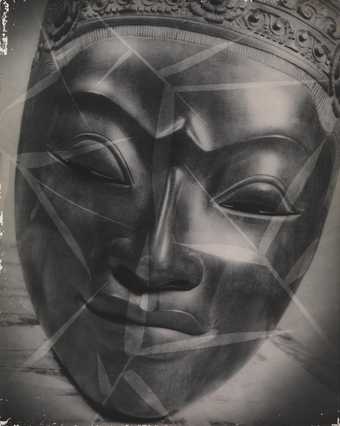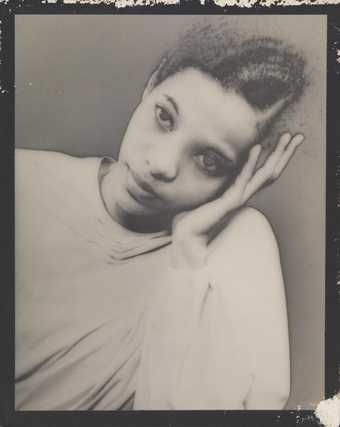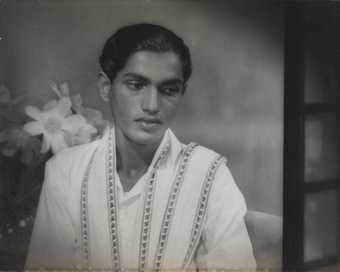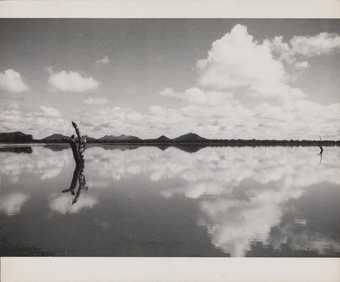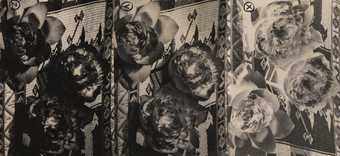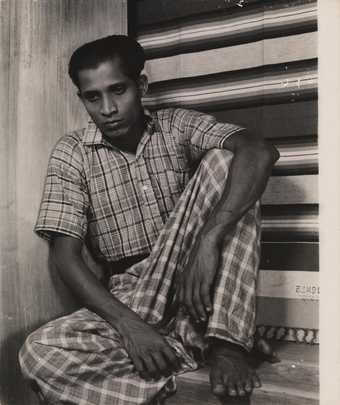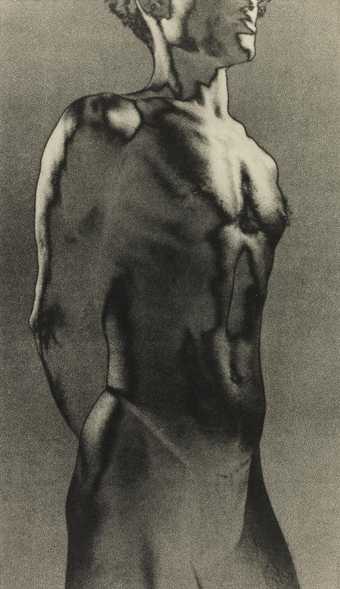
In Tate Britain
Prints and Drawings Room
View by appointment- Artist
- Lionel Wendt 1900–1944
- Medium
- Photograph, gelatin silver print on paper
- Dimensions
- Image: 380 × 303 mm
- Collection
- Tate
- Acquisition
- Purchased with funds provided by the South Asia Acquisitions Committee 2013
- Reference
- P80196
Summary
This photograph is a silver gelatin print on paper by Lionel Wendt, produced in Sri Lanka between 1934 and 1937. It depicts a female nude, cropped out of the frame at the neck, seated on patterned fabric. The print is heavily solarised, reversing the tone of the image and making darker areas and shadows appear white. Wendt’s use of this technique, along with the composition of the image, is reminiscent of the work of American photographer Man Ray, with whose work he was acquainted. While Wendt began photographing with a small Rolleiflex in the early 1930s, it is likely that this image was produced with a Leica, his preferred camera. It is one of fourteen photographs by Wendt in Tate’s collection (Tate P80193–P80213).
Lionel Wendt was born in 1900 in Colombo, Sri Lanka (formerly Ceylon) to a prominent family of Dutch and Sinhalese origin. His early life was defined by his talent for music. When he left Colombo for London in 1919 to study law at the Inner Temple (Wendt’s father, Henry Lorenz Wendt, was a Supreme Court judge and member of Sri Lanka’s parliament), he took the opportunity to train as a concert pianist, studying with Oscar Beringer at the Royal Academy of Music in London and later with Mark Hambourg.
During his time in Europe Wendt encountered modernism in music, visual art and literature, a discovery that was to impact upon the photographic production he started in earnest in the early 1930s. He kept abreast of developments across Europe and America following his return to Colombo in 1924 and amassed a large collection of the latest photographic technology. He also subscribed to a number of international journals, such as Photograms, Photographie and U.S. Camera, which he invited his contemporaries to make use of at his photo studio, Chitrafoto. Wendt maintained a close friendship with the Nobel Prize winning Chilean poet Pablo Neruda and acquired the latest literature for him from England during Neruda’s time stationed as Chilean Consul in Colombo between 1929 and 1930.
Wendt’s approach to photography was considered and based on extensive research. Many of the works in the Tate collection – such as [title not known] (Tate P80198), which depicts a natural object in a glass vase set against a backdrop of an ominous sky – show an engagement with modernist movements such as surrealism. Wendt also titled a self-produced retrospective of his work held in Colombo in 1940 Camera-Work, an act that historian Manel Fonseka has seen as a debt to the American journal of the same name and its editor, the photographer Alfred Stieglitz. (Manel Fonseka, ‘Lionel Wendt and Sri Lankan Modernism’, in Fukuoka Asian Art Museum 2003, p.13.)
As an artist and art educator Wendt played an important role in the development of Sri Lankan modernism, organising exhibitions and writing extensively for the benefit of artists and the public as well as acting as patron to a number of painters. He co-founded the Photographic Society of Ceylon in July 1935 and 43 Group in August 1943, a collective that sought to reaffirm the value of traditional Sri Lankan culture in the face of colonialism and state-sponsored academism. As artist and citizen Wendt had a strong sense of national identity and a broad knowledge of the culture and traditions of his native Sri Lanka: an understanding indicated by his central role in the production of the award-winning documentary Song of Ceylon in 1934, at the request of British filmmaker Basil Wright. Instead of simply reproducing modernist conventions in his photographic work, Wendt used what he had gained in Europe to convey the richness of Sri Lankan life and traditions. Many of his photographs depict local models and local scenes – from a traditional mask to examples of contemporary dress – reaffirming his role as a pioneer in the region.
Further reading
Eugène Prager (ed.), Lionel Wendt’s Ceylon, London 1950.
The Gaze of Modernity: Photographs by Lionel Wendt, exhibition catalogue, Fukuoka Asian Art Museum, Fukuoka City 2003.
Hannah Dewar
August 2012
Does this text contain inaccurate information or language that you feel we should improve or change? We would like to hear from you.
Display caption
Wendt is considered one of Asia’s earliest modern photographers. He was born in Colombo, Sri Lanka (formerly Ceylon) to a prominent family. Travelling to Europe in 1919 to study law, he encountered experimental music, visual art and literature. He kept up-to-date with developments in European modern art – including surrealism – on his return to Colombo in 1924. But instead of reproducing modernist conventions in his photographs, Wendt used what he had gained in Europe to convey the richness of Sri Lankan contemporary life and traditions.
Gallery label, October 2016
Does this text contain inaccurate information or language that you feel we should improve or change? We would like to hear from you.
Explore
- emotions, concepts and ideas(16,416)
-
- formal qualities(12,454)
-
- photographic(4,673)
- photographic negative(21)
- actions: postures and motions(9,111)
-
- sitting(3,347)
- woman(9,110)
- female(1,681)
You might like
-
Ryukichi Shibuya Untitled (Advertising photograph, woman in kimono)
c.1936 -
Ryukichi Shibuya Untitled (Cigarettes, camera & coffee)
c.1936 -
Shikanosuke Yagaki Untitled (Interior of wooden building)
1930–9 -
Shikanosuke Yagaki Untitled (Plant and wall)
1930–9 -
Ryukichi Shibuya Untitled (Advertisement for Laito Cream)
c.1936 -
Ryukichi Shibuya Untitled (Advertising photograph, mannequin hand and flower)
c.1936 -
Lionel Wendt [title not known]
c.1933–8 -
Lionel Wendt Untitled
c.1933–8 -
Lionel Wendt [title not known]
c.1933–8 -
Lionel Wendt [title not known]
c.1933–6 -
Lionel Wendt [title not known]
c.1933–8 -
Lionel Wendt [title not known]
c.1933–8 -
Lionel Wendt [title not known]
c.1933–8 -
Lionel Wendt Untitled
c.1933–8 -
Lionel Wendt Untitled
after 1934

